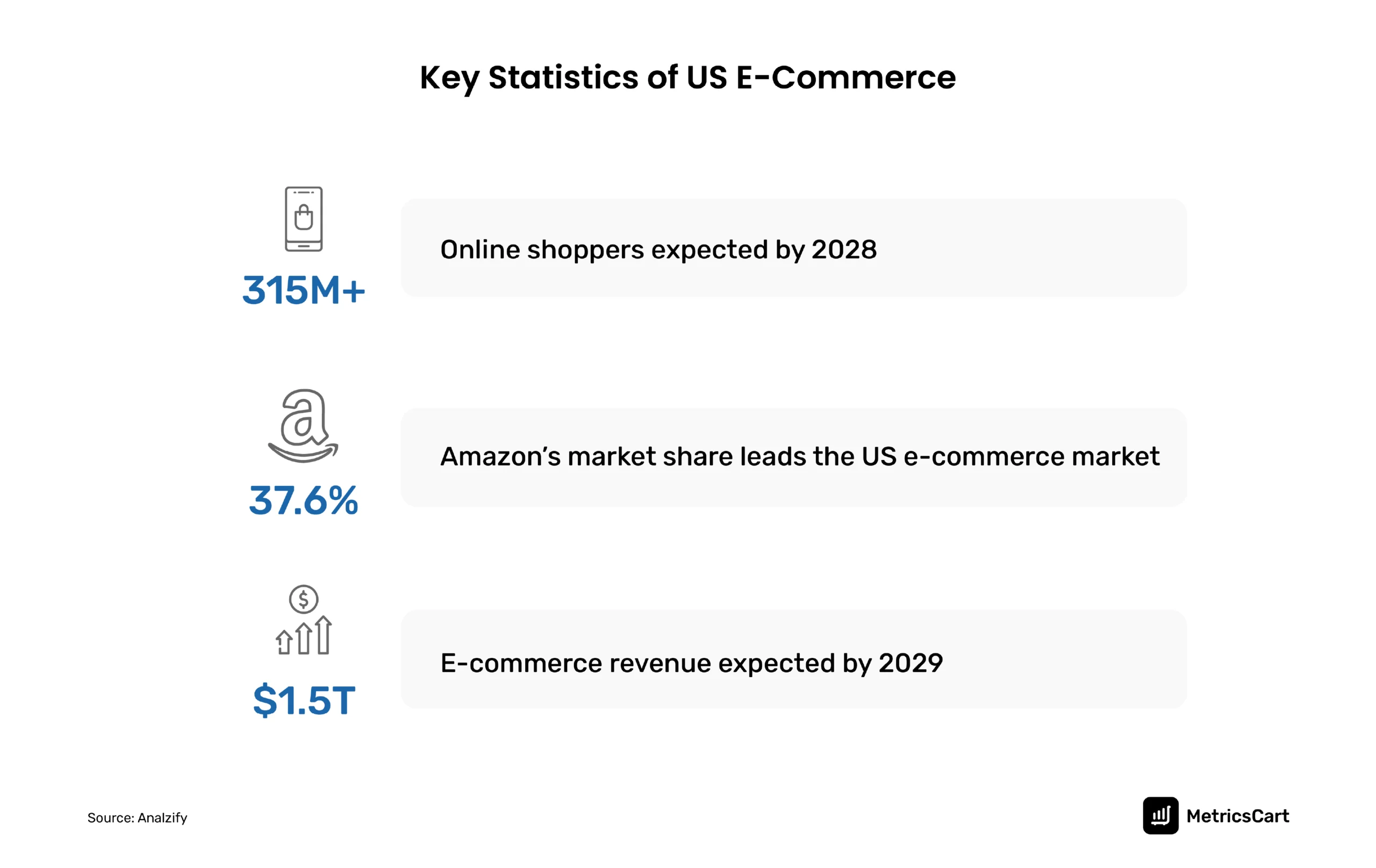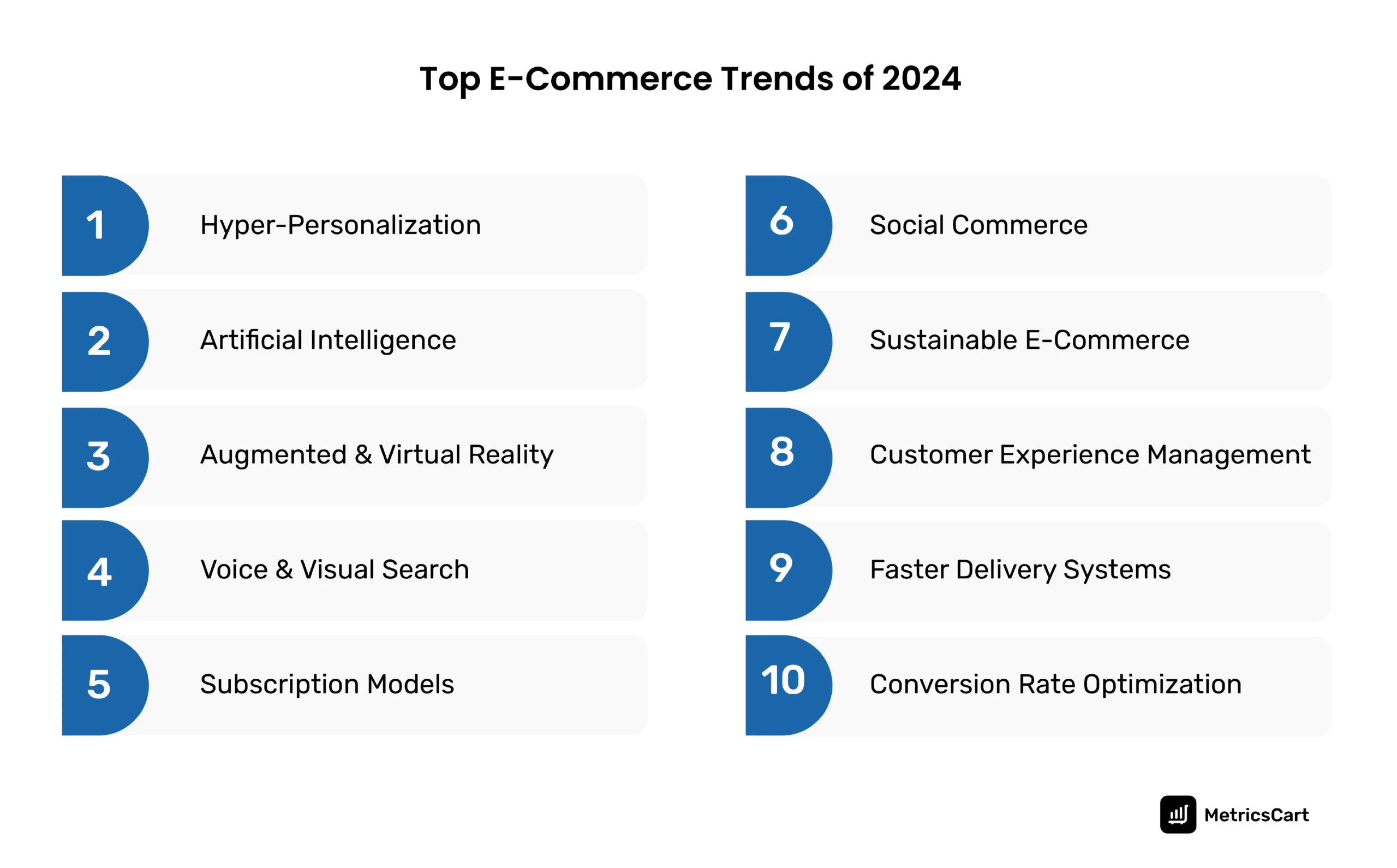Did you know that the US e-commerce revenue is expected to reach around $1.5 trillion by 2029?
That is a huge number, and how do online businesses plan to get there? Digital shelf analytics software is a great way to monitor, analyze, and customize your brand performance on e-commerce websites.
With the assistance of the latest technologies, such as Augmented Reality, Artificial Intelligence, Voice Search, etc., brands and sellers are creating a completely customer-driven experience.
This will help drive more sales and create better brand reputation management, as consumer preferences are also seeing a big shift.

Globally, the most preferred e-commerce category for 2023 was Holidays and Entertainment at 72%, closely followed by Tech at 54% and Clothing at 46%. Consumers prefer brands that listen to them and give consistent service through online and offline mediums.
These initiatives have pushed brands and sellers to create omnichannel customer service that delivers faster responses.
READ MORE | Interested to know more about the digital influence in retail? Read our blog, All You Need to Know About Digital Influence in Retail
Must Know E-Commerce Trends for Brands in 2024
E-commerce trends are chosen according to their applicability and relevance. These are the top e-commerce industry trends of 2024.
- Hyper-Personalization
- Artificial Intelligence (AI)
- Augmented Reality (AR) and Virtual Reality (VR)
- Voice and Visual Search
- Subscription Models
- Social Commerce
- Sustainable E-Commerce
- Customer Experience Management (CXM)
- Faster Delivery Systems
- Conversion Rate Optimization
Hyper-Personalization
According to a 2024 Deloitte report, 90% of consumers like personalized marketing. Hyper-personalized advertisements help brands to identify the individual preferences of consumers and tailor product recommendations.
Once the consumer gives consent to access their shopping data, it becomes the brand or retailer’s responsibility to offer them a highly personalized shopping experience.
Hyper-personalization helps to:
- Customize product recommendations according to shopping history and cross-channel searches
- Reduce the search time of products in the online platform
- Offer personalized goodies, discounts, and deals to boost sales
Artificial Intelligence (AI)
AI has been one of the breakthrough trends in e-commerce since 2023. With Gen AI and other intelligent tool sets, online retailers, brands, and sellers are finding it easier to streamline their inventory and sell products more efficiently.
Major online retailers like Amazon and Walmart have introduced AI searches, review summaries, pricing optimizations, etc., into their apps to make the shopping experience more convenient and swift.
AI chatbots and digital assistants are also breaking new ground in customer service and troubleshooting. These services make it easier for brands to allocate resources efficiently to sustain the omnichannel process.
Some of the major benefits of AI are:
- Optimizing supply chain systems and inventory management
- Trim the digital marketing process to create easily consumable content
- Suggest personalized shopping recommendations using consumer data
Augmented Reality (AR) and Virtual Reality (VR)
AR and VR technologies have been creating genuine curiosity among consumers. Brands and retailers are also adding these features to their websites for an interactive experience for their customers.
These features help them learn about products and their features up close without the need to visit a physical store.
Some major benefits of AR and VR include:
- Interactive product descriptions and visuals for customer convenience
- Heavily invested technology by big companies that makes it future-proof
- Creating a bridge between digital and physical shopping experiences
READ MORE | Ever heard of phygital stores and how they are used in the e-commerce business? Check out our blog Exploring Phygital In E-commerce with Industry Examples.
Voice and Visual Search
Any brand or seller’s ultimate goal is to identify methods that ease the shopping process and allow customers to choose products quickly.
It is estimated that by 2025, almost 75% of US households will own a smart speaker. Voice ordering, voice search, image search, etc., are part of this new trend in the e-commerce business.
Several brands and retailers have added this feature to their apps, enabling voice and image-based product searches. Voice-based ordering can be done through smartphones and digital assistants like Alexa, Google Home, etc.
Subscription Models
Subscription-based services have been around for a long time, and even in 2024, consumers prefer them. Online retailers and brands create tier-based subscription models that are personalized according to customer needs.
For retailers, this model proves to be a consistent income source and a strategy for continuously monitoring consumers’ preferences.
Brands can offer exclusive offers, early access content, loyalty programs, and more, making subscription models one of the most sought-after and successful e-commerce trends of 2024.

Social Commerce
Emarketer projects that by 2025, $79.64 billion in sales will be made through social commerce in the US. This shows the immense power of social media’s influence on consumer preferences.
Social commerce is the process of using online social media, such as Facebook, Instagram, Pinterest, TikTok, etc., to sell products and services commercially.
Social commerce can be useful in:
- Creating cost-effective marketing strategies for brands
- Making a collaborative product promotion with social media influencers
- Reaching a wide range of target audiences and demographics
Sustainable E-Commerce
According to an ESW report, 63% of consumers globally value brands that are transparent and truthful about their environmental sustainability options. Consumers have made it a point to support brands that take sustainability efforts seriously.
This has led certain brands and sellers to restructure product-related processes, such as sourcing raw materials, packaging, delivery, etc., in an environmentally conscious manner.
Sustainable e-commerce leads to:
- Better management of the environment and its resources
- More brand value and loyalty as Gen Z and Millennials prefer eco-conscious products
- Brands creating new ESG (environmental, social, and governance) projects
Customer Experience Management (CXM)
In today’s world, brands are expected to sell products that ensure continued support throughout the consumer life cycle. This has become primary for sustaining brand value and retaining customers.
CXM defines how a brand or company should represent itself to customers by monitoring, interacting, and organizing its product journey.
Benefits of CXM include:
- Better consumer feedback system
- Loyal customer base leading to better recommendations
- Knowing competitor position through ratings and review monitoring
Faster Delivery Systems
With the growth of e-commerce, the challenges of delivering the product safely and on time have also become a top priority for retailers and sellers.
According to a report by CSCMP’s Supply Chain Quarterly, 62% of e-commerce consumers expect product delivery within two to three business days.
Consumers also tend to prefer sellers who provide low or free shipping costs for products, and this has become a consistent trend in 2024.
For brands and sellers, this has become an opportunity to try out innovative delivery methods, such as drone delivery, driverless vehicle delivery, and drones.
Conversion Rate Optimization
Observing global e-commerce business trends, the average cart abandonment rate is reported to be 70.19%. Thus, one of the greatest challenges of an online brand is converting website traffic into successful sales, and this process is measured using a conversion rate.
Conversion rate analysis helps retailers, brands, and sellers identify issues with product page optimization, website or app interactivity, payment options, delivery, etc.
Optimizing these points can lead to better sales and overall brand performance. Digital Shelf Intelligence tools offered by services like MetricsCart can monitor and analyze brand performance to improve conversion rates.
READ MORE | Still confused on the common challenges brands face? Read more on the common e-commerce mistakes.
Conclusion
The above-mentioned trends should be implemented and maintained according to consumers’ behavior and preferences. These strategies don’t follow a one-size-fits-all philosophy; they should be included in the e-commerce business according to the specific requirements of the brand or retailer.
MetricsCart, a digital shelf analytics software, offers multiple services, such as search sharing, content compliance, MAP monitoring, ratings and reviews analysis, etc. These tools help you create clear-cut performance indicators that can help scale your online brand.
Get on a discovery call with us to know what DSI trends can improve your e-commerce business.






